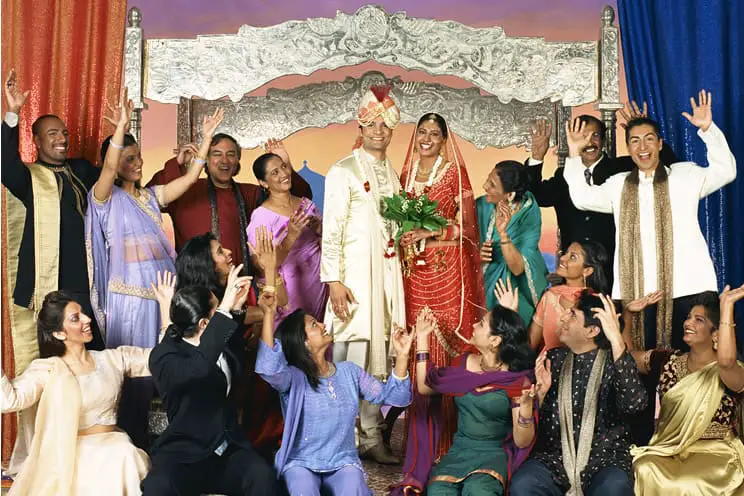
Hindu marriages and weddings are very different than weddings in many other cultures, denominations, or countries. Besides there being multiple different types of marriages and the various ways a relationship can form, weddings in the Hindu religion tend to be colorful, extended celebrations filled with a lot of love and rooted in tradition.
While we may often imagine a wedding as just one day of celebration in other cultures, it may surprise you how elaborately drawn out and multifaceted Hindu weddings are. While not all Hindu weddings are identical in pre- and post-wedding practices, here are thirteen festivities and traditions involved in how Hindu weddings are celebrated.
How Many Ceremonies Are There in Hindu Weddings?
There are many different ceremonies involved in Hindu weddings. Traditionally, there are about half a dozen ceremonies leading up to the wedding. And, the festivities carry on for around seven or eight ceremonies after the couple ties the knot. There are over one dozen ceremonies involved in Hindu weddings, making Hindu weddings unforgettable and treasured experiences for couples and guests alike.
Below you can find in-depth descriptions of each beautiful ceremony. Some of these take place over the weeks and months leading up to the wedding. The wedding itself is also usually a three to five-day celebration in and of itself, making Hindu weddings a lovely chapter in a couple and their families’ lives, not just a day.
While we may have come to expect weddings to be one long day, a Hindu wedding is a celebration that spans over days and involves many loved ones and sacred traditions.
Engagement Ceremony
As its name implies, this is the day that a couple chooses to spend their life together. While one might imagine the future groom getting on one knee, it is actually quite different. The name of this ceremony varies by region and practice, but generally, the happenings of the day are the same across the denomination.
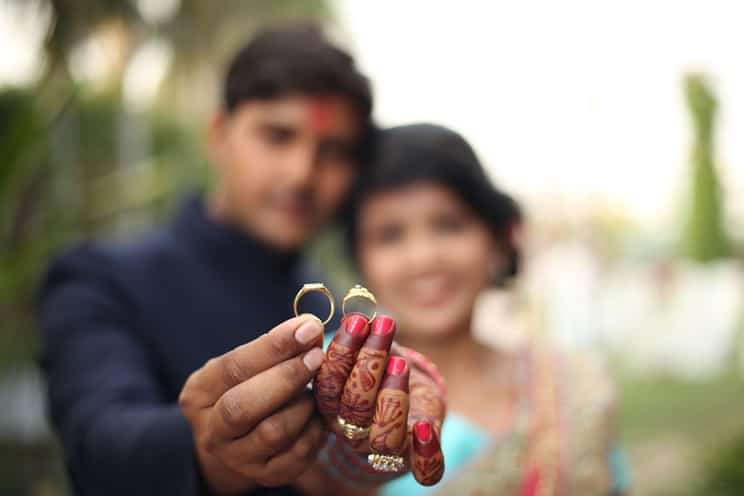
Essentially, this is the day that rings might be exchanged, but it is much more than that. The couple’s families unite, offering each other gifts and welcoming each other into one another’s families. It is much more than just a man proposing to a woman. It is actually the day that families approve of the union and give their blessings.
Sometimes, the family decides the date of the wedding as a group. However, the wedding itself is not seen as the most important element. This is more of a declaration and celebration of a marriage than a big party to plan an even bigger party – the wedding. This is more of a breaking-of-bread type of ceremony and kickstarts the unity between two families.
Ganesh Puja
The Ganesh Puja ceremony kicks off actual wedding ceremonies. This is a deity within the Hindu religion that is thought to bring people prosperity and remove obstacles from their path. It is rooted in that, with the name honoring him from the get-go.
Since this ceremony is centered around Ganesh, a statue of Ganesh is decorated and surrounded with items that also have a great deal of spiritual meaning. Red flowers may adorn his neck, incense burns, and they honor him and pray for good fortune throughout their wedding.
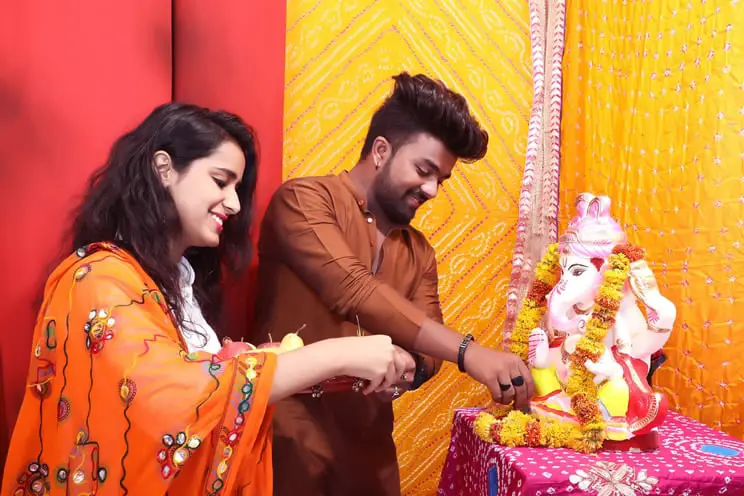
This can be a part of the several-days-long wedding, or it can happen in the days leading up to the wedding. But, apparently, this is an essential part of any type of Hindu wedding as Ganesh’s blessings are very important to couples and their families. These wishes of good fortune are crucial when entering into a marriage.
Fun fact: Ganesh is known to be a god with many arms and an elephant head. Elephants are known to be full of wisdom, and his “large ears mean that he can clearly hear the needs of his people.” That being said, who would not ask this deity to bless their wedding and their marriage forevermore?
Mehndi Ceremony
The Mehndi ceremony is where the bride is decorated with henna. Grooms also traditionally have this ceremony, and while it used to be common practice for the ceremonies to be separate, many couples now choose to do this ceremony together.
The family usually attends this ceremony, and henna is the main focus of the ceremony. There is also a ton of singing and dancing, bringing positive energy and a good mood to the wedding. For women, it is beautiful, decorative, and spiritual. For men, it is a good omen for their marriage.
This is usually the day before the actual wedding, and can both elevate the mood of the celebration, and create strong ties between families. When they are done together, the joining families can create stronger bonds. When done separately, brides and grooms can bond with their respective blood relatives as they prepare to enter a new chapter of their life. Either way, it is definitely a celebration that brings together families.
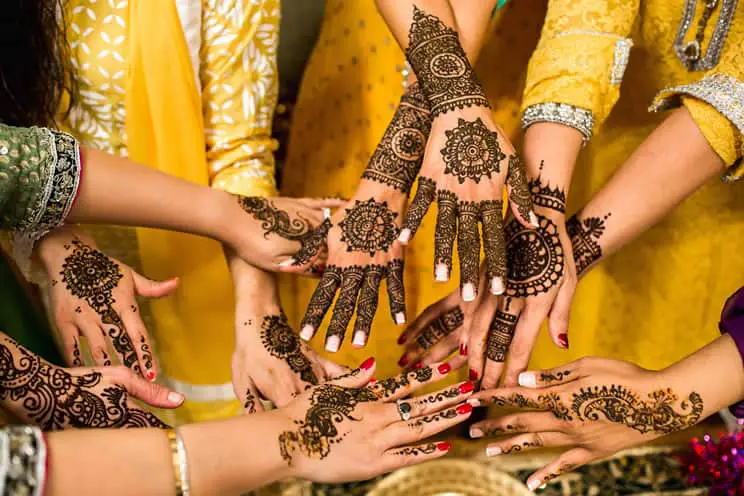
Fun facts: While henna has health and pretty, it also attracts positive energy and fertility. These are both really powerful things to incorporate into a blossoming marriage and wedding. The strength of the color and how long it holds up can both be symbolic of the depth of the love between the couple and the longevity of their relationship.
Also, sometimes the groom’s name is hidden somewhere in the elaborate designs. It is traditional that he has to look for it. “We all love this tradition as it is really fun to watch the groom study the intricate design on his bride, and it is believed to show how much patience the couple will have,” brides.com describes.
Sangeet Ceremony
This ceremony is the biggest of all of the pre-wedding ceremonies. It is a festivity rooted in much less seriousness and spirituality and is intended to bring the families together in a more lighthearted manner. Family members coordinate dance performances to present to the couple and the rest of the family. Often times the couple performs as well!
Music and dance are the focal point, and it is a carefree, cheerful environment that allows everyone to relax amidst wedding planning stress. There are traditional ways to celebrate this, involving long-established spiritual colors and music. Some people have made this a very modern affair with themes and various genres of music coming into play.
Fun fact: This is a tradition that originated in Northern India. Over time, this tradition has spread to other regions of India and, therefore, other legs of the Hindu religion. And, Sangeet appropriately means sung together– which is a perfect depiction of what is expected during this gleeful celebration.
Tilak Ceremony
We have focused on more bride or couple centric ceremonies thus far. The Tilak ceremony is based around the more so than the couple or the bride at all. The father of the bride offers gifts and good fortune to the marriage, and the groom’s father, as well as the groom, gives gifts to the bride. But the underlying purpose is for everyone to come together and give their approval of the groom.
Usually, this ceremony revolves around the men of both families, and women often do not attend. It includes ceremonies where various people apply Kumkum to the forehead of the groom, representing different things dependent upon placement and who is applying it to the groom.
While it does not directly involve the bride, the goal is that the vermillion applied will bestow a long, loving marriage. The hope is that putting the tilak on his face will encourage him to be a strong and adoring husband to his wife. While she is not necessarily part of it, her wellbeing is central to the ceremony and the motives of the ceremony.
Fun fact: Kumkum, or vermillion, is a powder widely used for many different practices within Hindu practices both inside and outside of wedding traditions. It is centered on prayer, longevity, and wellbeing.
Haldi Ceremony
All of these ceremonies sound spiritual, or fun, or maybe even a combination of both. But the Haldi ceremony is maybe one of the messiest ceremonies mentioned thus far! This is a large celebration where the couple is coated in turmeric paste- that is right. The couple is caked in a yellow paste and look gold.
This takes place within a day or two of the wedding and starts out very sacred. As we have seen, all of these ceremonies are deeply steeped in conventional Hindu beliefs. This one is no exception but also takes a fun turn after the paste is applied.
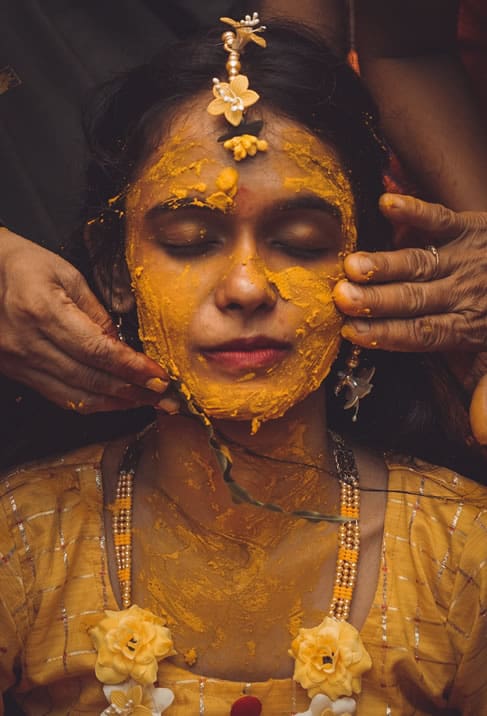
Besides the brightening effects of turmeric (people often use turmeric in their oral or skincare routines to brighten), there is also an element of protection from negative spirits and vibes before the big day. It is also said to be a calming agent, scientifically, that helps the couple stay calm and grounded, leading up to their nuptials.
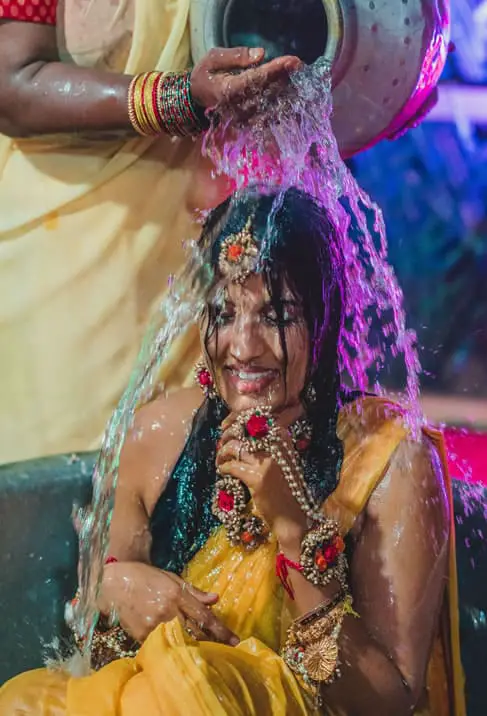
Like many other ceremonies, this one ends in laughter, love, and lots of fun. Dancing and singing ensue and, between that and the soothing effects of the paste, this is a mood-lifting, beautiful ceremony that brings the couple and their families together in both festivities and spirits.
Fun fact: Yellow is thought to represent a prosperous future. So, while this process may just seem like a silly mess, every single element is beneficial to the couples’ minds, bodies, and souls.
Wedding
The actual wedding is immersed in a lot of tradition. While some of the rituals we have talked about aren’t necessarily included in every rendition of a Hindu wedding celebration, the actual wedding itself involves non-negotiable elements that almost every single Hindu wedding includes to be considered legitimate.
There are about seven steps in a traditional wedding ceremony that allow the wedding to be considered official and complete. The bride’s family is responsible for hosting this ceremony.
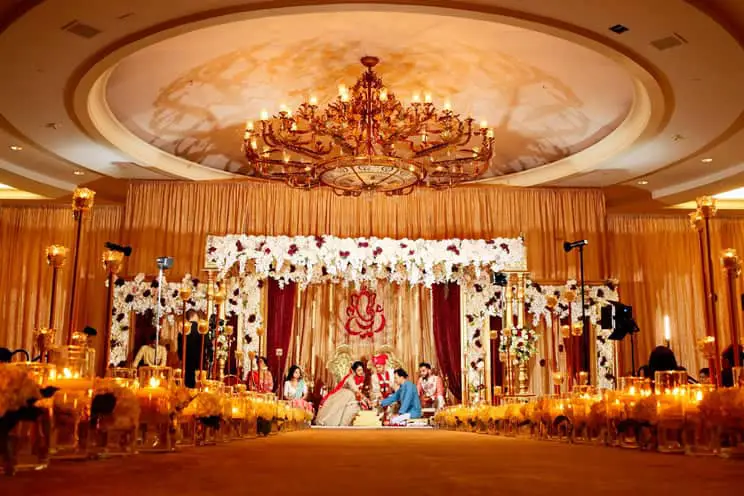
In a lot of Western cultures, the bride is given away by her father to her husband-to-be. That is something that happens in Hindu weddings as well. There are a lot of other elements, such as promising each other a bountiful and strong love and marriage. The families are still very involved, with marriage meaning a lot to the parents of the bride and the groom for deeply sacred reasons.
The couple is “repaying their debts” to their ancestors who came before them. And, the bride’s family is forgiven for past transgressions. A lot is riding on a marriage besides couture dresses and Pinterest-worthy décor in the Hindu realm. Marriage is a large blessing and responsibility. It is also forbidden to be absolved in this culture, meaning it is actually seen as a forever thing as opposed to what we may be used to in some Western religions and cultures today.
This ceremony ends in the couple taking seven circles around the fire under the mandap, a very ornate altar-like structure. Their clothing could be tied together to connect them further, depending on the region. That is more of a Northern India tradition. These circles each represent their own commitment and vows within the marriage. The vows are as follows:
- Uphold health, tradition, and responsibilities
- Develop spiritual strength
- Grow and stay prosperous
- Mutually respect and therefore mutually grow together
- Strong children
- Long lives
- True friendship and commitment
There are different variations of the seven steps amongst different regions in India. But the principles always remain the same, and the significance of either stepping or circling seven times remains consistent no matter where you might attend a Hindu wedding.
Fun fact: When the groom arrives, there is a ton of celebration and dancing. There is a small parade of sorts that ushers him into the ceremony separate from his future bride’s loved ones. It is a “last hurrah” of sorts as he embarks on a new journey.
Vidaai Ceremony
This is the first of the post-wedding celebrations. Whereas every ceremony mentioned above has been exciting and positive, this one is a little more upsetting and solemn for the bride and her side of the family. Though the process is boisterous and exciting leading up to the wedding, it also means that the bride is a part of the groom’s family, not her own. It marks the beginning of a beautiful new era, and also the end of a chapter of youth and familial connection.
As the bride leaves, she typically throws rice and coins behind her to invite good fortune into her family’s home even after she has gone. It is a well wish and an offering of protection and love. It is seen as a bittersweet parting gift.
She then parts with her family, they hand her off to her husband, and she continues sprinkling rice and coins as they pull away to ensure that the prosperity that she wished upon her family follows her into her new life.
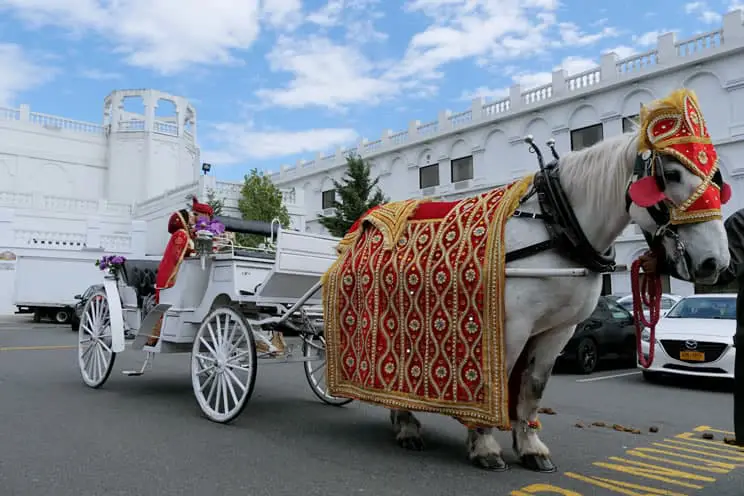
Fun fact: Arranged marriages still exist in the Hindu culture, but they were much more prevalent long ago. Usually, daughters were given to royalty as gifts never to be seen again in exchange for good luck and fortune. Vidaai dates back to these times and used to be way more solemn, as brides often never saw their families ever again.
Reception
Now that the bride is a part of the groom’s family, it is now time for her to meet all of his people and be fully intertwined with the people closest to him and his family. While this is traditionally the purpose it serves, research has concluded that modern receptions often still involve the bride’s family as well.
Similar to any wedding reception you may have gone to or come to expect, this is a glutenous event with lots of food, dancing, and celebrating. It is often a huge celebration, involving even more friends and distant family than preceding ceremonies.
It is fairly informal and mostly congratulatory. However, at one point, everyone will throw money at the newlyweds to offer them prosperity. A common theme you may have noticed throughout the entire celebration: prosperity is something interwoven into almost every element.
This festivity is also very concentrated on food. There is often a feast, boasting both traditional Indian food and many other types of cuisine. With all of the singing and dancing, it is expected that everyone needs something to fuel them after a long span of celebration, and still some to come. These receptions are notorious for their feasts.
Aashirvaad (Ashirwad) Ceremony
This is a post-wedding blessing ceremony that involves receiving well wishes and blessings from everyone who witnessed their wedding. It is, again, an opportunity to receive bountiful aspirations of good fortune.
Some of these well-wishers come baring gifts for the couple, and in return, they touch the feet of these people to thank them and accept their blessings and wisdom. The bowing and touching of the feet is more applicable to the elderly attendees, as they are often in strong marriages and are seen as wise.
Dwar Rokai Ceremony
Next up in the post-wedding ceremonies is the Dwar Rokai ceremony. This one is mostly based in antics and comedy and is only something that can be accomplished when the groom has a sister. It is also more of a regional thing, and you will not find it everywhere. Both because not all grooms have a sister, and because it is not quite as widespread of a tradition.
The sister of the groom stands at the entryway of the groom’s family’s home and refuses to let them in without some sort of bribery. She may require a gift from the groom, or some money, or both! It is not ever considered a serious fight, but more symbolic of the bonds between siblings. It is one last shot as some childish rivalry, especially now that the groom will likely not be living in the family home.
This portion of the day can be refreshing, especially after the vidaai ceremony. There are some melancholy associations with that part of the day, and the comedic jaunts can lighten the mood.
Mooh Dikhai Ceremony
As we have seen, while a large amount of the focus during before the wedding has to do with approving of the groom, the celebration and ceremonies that ensue after the wedding are very focused on making the bride feel comfortable with her new family. With the tradition being so rich, and the pillars of the marriage being that she is no longer part of her own family, it can presumably be really intimidating and scary.
The whole point of the Mooh Dikhai ceremony is to add another layer of welcoming and warmth to the bride’s journey into her new husband’s family. The family of the groom, usually specifically the groom’s mother, offers the bride gifts. They can be elaborate jewelry or saris.
While being a great welcoming effort, it also really invites the bride to feel comfortable and seek to build strong foundations in her relationships with her new family members. Having blessings and sharing wisdom with her new mother-in-law is likely important to both the bride and her husband, as well as his family. They have this woman in their family for life!
Fun facts: This used to be a means of introducing the bride to any women in the groom’s family. Women were not welcome to the wedding long, long ago, so it is truly rooted in lighthearted, open-armed introduction. In some cases, this would be the first time the women of his family would even see her face fully, but in more modern times, it has become a more fun tradition.
Pag Phera Ceremony
What a relief! I told you that the Vidaai ceremony is not so sad anymore in modern times!
The Pag Phera ceremony is a family reunion of sorts. The bride goes to check on her family, making sure they are as happy and healthy as they were when she left. In some specific denominations within the culture, the groom also comes to visit them for the first time since they have transitioned into their life as man and wife.
Sometimes, again depending on the region and branch of the culture, gifts are given to the couple again, especially to the groom, as he is now bearing the responsibility of being a good caregiver and husband to his wife. One of the pillars of the marriage was that he would shoulder her worries, and that is not a vow that the bride’s family will take lightly with their belief that this marriage has absolved them of that responsibility and the bad karma from their past.
The family is, of course, thrilled to see their daughter, and it is presumably a relief for her to get to visit her childhood home and see that there is still some familiarity amongst this big change. She may also be given gifts from her parents because they are grateful that she has come back and brought along the same prosperity she has found in her new life.
Usually, this also involves the bride (and the groom, if he comes) staying in her old home for days at a time. If she has a brother, he will escort her back to her home for this process as well. It involves her entire family and unites her old life with her new life in a way.
Conclusion
Clearly, what we may have come to expect at a wedding is blown away by the festivities and rich traditions involved in a Hindu wedding. There is a huge level of family involvement. The entire process, beginning to end, no matter how it is ordered, is deeply embedded in tradition and spirituality.
It is almost a beautifully rich story that plays out within every wedding, one that details the powerful traditions that come before the celebratory couple, and the prosperous future that they envision for themselves hope to create.
With the symbolism of each and every color, flower, and deity represented, it is no wonder that so much goes into a Hindu wedding. With over thirteen ways to celebrate a Hindu wedding, there are layers that we did not even get a chance to touch on.
Gods and goddesses are honored in the minute details. The hopes and wishes of both the bride and groom are interwoven into seemingly insignificant details that one might overlook or spend a ton of money on for no reason in a typical Western wedding.
That said, there is no shortage of fun and excitement in each piece of a Hindu wedding. There is a great deal of jubilee and bliss also involved. Where one might think something so traditional would be boring, Hindu weddings completely go against that. Though they often shoulder the burden of their families’ expectations, the ways that they work those hopes and dreams in is very beautiful and symbolic.
